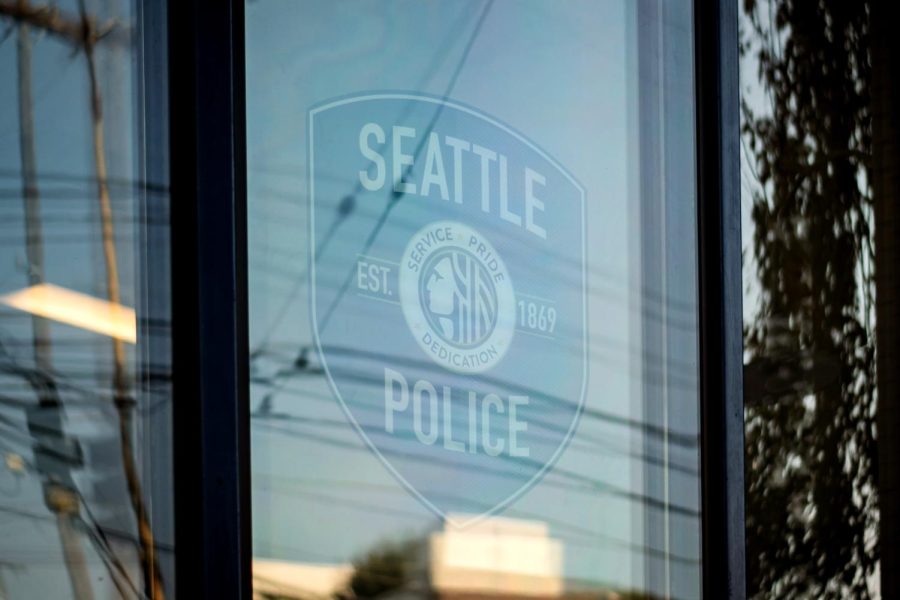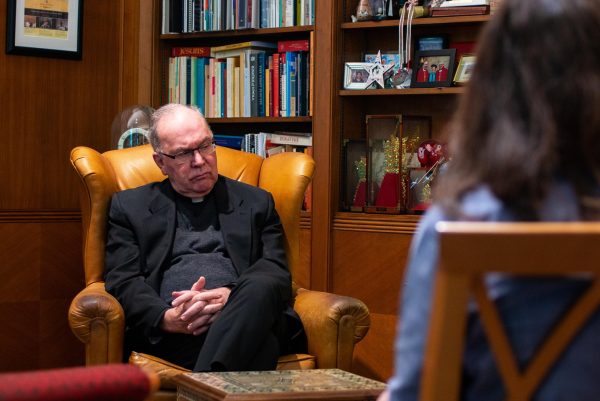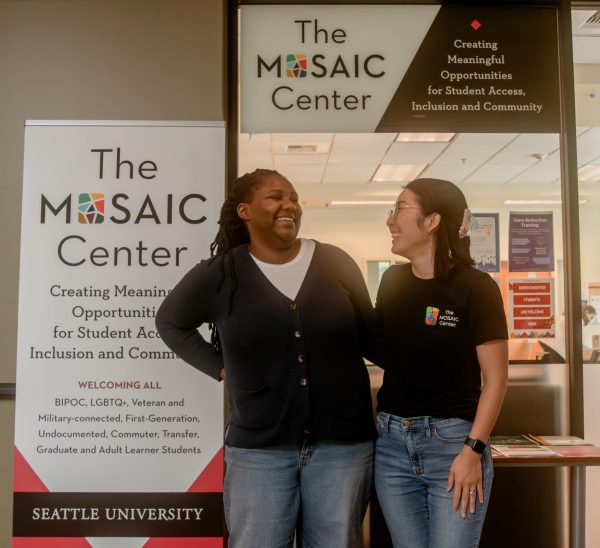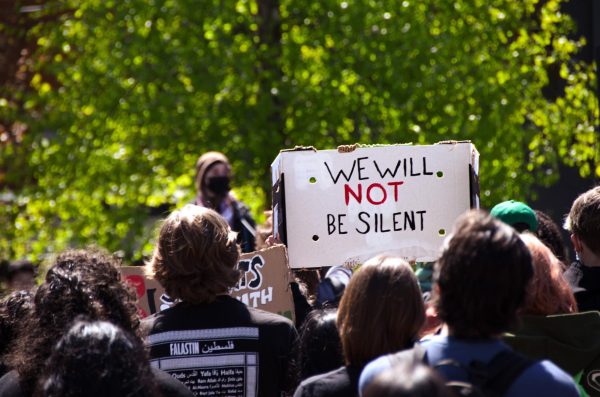Did Seattle Just End “Defund the Police?”
The Seattle Police emblem in the window of the East Precinct surrounded by reflections of the street.
“Stop killing us! Stop killing us! Stop killing us!”
This is one of many chants that united national uprisings in the wake of George Floyd’s murder by Minneapolis police officer Derek Chauvin. As the nation and world saw mass uprisings that challenged the legitimacy of policing bureaucracy, many activists, young people and even some insulated homeowners, organized under the banner “Defund the Police.”
Seattle, a city that amassed a vast defund movement, saw an ambitious commitment to cut the Seattle Police Department (SPD) budget. In July 2020, seven of the nine Seattle City Council members committed to defund the SPD by 50%. The plan was pushed by Decriminalize Seattle and King County Equity Now; organizations composed of left-leaning non-profits, established community groups and other like-minded collectives.
The framework sought to slice the then $409 million dollar SPD budget in half and use the funds to invest in community solutions to crime, inequality and poverty. After City Council rebalanced the budget in Aug. 2020, defunding the SPD by $3 million and directing $17 million towards alternative police responses, a complete reconfiguration of Seattle’s public safety system seemed feasible—and potentially likely.
“Today, City Council inched us towards a safer future,” King County Equity Now said in an Aug. 2020 statement. “A future where instead of using our limited taxpayer resources [for police officer’s salaries], we allocate those funds towards data-driven, community-based solutions that we know prevent harm—not merely respond to it.”
The changes demanded by activists and organizations never materialized.
Instead, in the two years after City Council’s pledge, the SPD budget was reduced by roughly 17%—“defunding” mainly attributable to shifting Parking Enforcement and 911 dispatch out of SPD purview. As far as community solutions to crime, they remained less funded compared to their traditional enforcement counterparts.
While Seattle was ostensibly in the process of reimagining its public safety apparatus, crime rose, 911 response times lagged and homelessness spiked. This phenomenon played a major role in defusing the movement.
“Across urban America the evidence is piling up that when you demonize police and their budget, you get more crime,” a 2021 Wall Street Journal editorial summarized.
“Defund the Police,” hamstrung by narratives which were disputed by activists, political backlash and increased crime throughout cities, receded from mainstream discourse as the traditional system of policing was vindicated once again.
“The pressure for the new thing to somehow perfectly prove that it can fully resolve all of the concerns folks raised about ‘Defund the Police’ are always hovering out there,” Zachary Wood, assistant professor of public policy at Seattle University said. “So, [the city] puts a pilot program together, it’s minimally funded, it’s not organized quite yet, and then crime rates rise. And we can very easily jump in with the narratives we’ve already built into [rising crime rates] like ‘if you reduce police presence crime will increase.’ That’s a logic that’s existed with us for a very long time. But it might be a misunderstood logic.”
In 2021, Seattle distinctly turned away from calls for SPD disinvestment when Bruce Harrell beat Lorena González—the former progressive City Council president who outwardly supported defunding and reconfiguring the SPD—in the mayoral election. Harrell, a moderate during his tenure on City Council, campaigned partially on the cultural and fiscal resurrection of the SPD.
Harrell’s election proved that, even in seemingly progressive cities, ‘Defund’ fervor was rapidly extinguishing. With antipathy towards Defund the Police proponents rising, national attention has also turned away from the movement.
“When it comes to public safety in this nation, the answer is not Defund the Police. It’s fund the police,” President Joe Biden said in late Aug. 2022.
Biden’s comments, along with less public focus on police killings, which reached a six-year high of 1,054 deaths in 2021, prompted national pundits to declare the Defund movement dead. Seattle’s own unprecedented divestment from the SPD ended only weeks before Biden’s speech.
The Police Recruitment and Retention Plan, introduced by Mayor Harrell and passed by City Council in mid-Aug. 2022, sought to ameliorate the steady depletion of the SPD force. An issue that started long before the 2020 uprisings, but accelerated in the past two and a half years, despite minimal cuts to the actual police budget. The SPD numbered 1,348 sworn personnel in 2020, and only 1,137 in June of 2022, a “staffing crisis” spurred by the exodus and retirement of over 400 SPD officers.
“We’re going to get a little more sophisticated in our approach,” Harrell said in a news conference after proposing the plan. “Because, as we well know, in the private sector, companies spend a lot more money in advertising and recruiting.”
After two years of consecutive divestment from the SPD umbrella, with no substantive investment in another public safety response team, Harrell’s announcement gestured towards an unintended outcome of public advocacy of defunding police departments: the privatization of law enforcement.
Through various community levies the Downtown Seattle Association—a non-profit representing over 1,700 businesses, nonprofits and downtown residences with the goal of creating “a healthy, vibrant downtown for all”—spent $564,000 on private security between June 2020 and Aug. 2021. $314,000 was spent on private security for Westlake Park and Occidental Square alone.
“Even a successful Defund campaign might mean the ratcheting up of private police and property protections,” Sarah Cate, assistant professor of political science at Seattle U said. “If you get rid of publicly funded police, but the function and need [to protect private property and monitor public space] still exists, then, in that sense, it’s really a conservative proposal because the likely result is privatizing a function of our society.”
When the city simply moved Parking Enforcement from SPD purview into the Seattle Department of Transportation, it also resulted in costly oversights. Over 100,000 parking tickets were refunded, and another 100,000 were voided. Parking enforcement officers, after transitioning from the SPD last fall, were not granted the legal authority to write tickets. The Seattle Times priced the mistake at $5 million.
“The Defund movement was a knee-jerk reaction to an ugly event,” Al O’Brien, former SPD Sargent, chairman of the House Criminal Justice & Corrections Committee, and assistant professor at Seattle U said. “But City Council didn’t think it through. They got a lot of pressure from their constituents, and they said, ‘okay we’re going to take 50% away.’ They didn’t think it through.”
Mayor Harrell, in an attempt to confront these shortcomings, presented his 2023-2024 budget, Sept. 27. The proposal, to the dismay of many Seattle activists, adds $20 million back into the SPD budget pushing the police price tag to $375 million in 2023, and $385 million in 2024. These figures are close to the $409 million budget the department boasted at the outset of 2020.
Akin to the 2020 and 2021 SPD divestments, the majority of the $20 million goes to transferring Parking Enforcement back under the SPD umbrella, along with $2 million to “explore and diversify 911 responses.” But the reinvigoration of the SPD budget, despite its potential pragmatism, sends a message about the city’s approach to criminal justice. Not least because the decision to fund SPD—and offer substantial signing bonuses to new officers—is a decision not to fund more social extensions of the State.
“[The mayor is] saying a lot of good things, his intentions sound really great, but I’m anxious to see results,” SPD Officer Donald Bolton, one of over 120 plaintiff officers who sued the city over use-of-force reform back in 2014 said. “[We need to] get to the root of the problems causing the crime rate.”
It remains unclear how to approach the fundamental issues spurring crime; after all, the root causes of crime are myriad and highly contextual. For many, it’s hard to believe that the SPD can reduce crime by any significant metric.
“We understand crime not simply as the presence or lack of presence of enforcement, but crime as a result of discord, inequality and poverty,” Wood said. “The reason why people engage in stealing or drug dealing is much more attributable to poverty and wealth inequality than it is simply to some weird notion that some people are bad, and some people are good and the only way to keep the bad people in line is to have some people in uniforms that make sure they do the right thing.”
Seattle’s recent return to SPD budget boosting and away from activist-inspired alternatives like The Solidary Budget, which demands 50% divestment from the SPD to markedly reinvest in communities—to progressive activists signifies a deeply embedded contradiction in the city’s political orientation.
“This is a failure of progressive politics,” Charles Lawrence, associate professor of sociology at Seattle U said. “Seattle is one of the most progressive cities in the United States, and this is the same with San Francisco and Los Angeles and Portland. We have an ongoing homeless problem, we have issues with policing functions, we seemed, as a community, to be interested in alternatives to policing and yet we sit here today, and we have not, as a community, grappled seriously with these problems.”
Harrell’s budget proposal, which will go through a process of deliberation and public hearing before adoption in early December, marks the definitive end of Seattle’s Defund uprising; by funding the police without substantially divesting in the first place.
For now, Seattleites looking for an alternative public safety response will have to put their faith in a “third department” agreement between Harrell and City Council. Plans for the alternative response team are expected at the end of the year, with the intention of starting the program in 2024.











